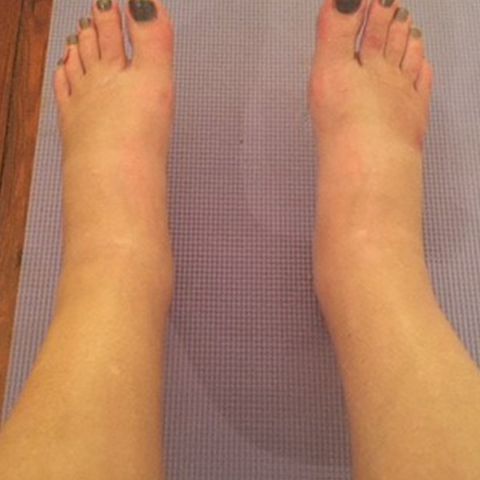
My symptoms started creeping in during the summer of 2016, just weeks after I’d done a 100-mile cycling ride.
I was tired all the time (I could sleep for 15 hours a night) and constantly felt short of breath, even during my usual easy workouts. But I chalked it all up to my crazy work schedule—as a FOX Sports reporter, I practically lived on the road, covering game after game.
But things got worse at the beginning of September—also the start of NFL season and the beginning of prep for NBA season—and I started to get more and more worried about the fatigue and shortness of breath. I was waking up close to 15 times a night to catch my breath, and I even began sleeping on my couch at a 90-degree angle, so I’d be able to sleep through the night.
“As I made excuses for my symptoms, my heart was becoming more and more enlarged.”
I saw my doctor for a chest x-ray, but it didn’t show anything concerning, so once again, I figured I was just working harder than usual. At 38, I thought maybe this was all just a part of getting older, too. Thinking maybe air quality was a potential culprit, I bought an air purifier, as well.
All the while, as I made excuses for my symptoms, the left ventricle of my heart was becoming more and more enlarged, struggling to pump blood throughout my body.
In mid-September, it all started to hit me: I took a nap during my lunch break—and didn’t wake up until the next day.
I was trying to push through and be on top of my game as football season was getting started. To say I love my job is a understatement—I had worked hard to get to where I was, and I wasn’t prepared to let these strange symptoms slow me down.

But then, during a day of preparation for the upcoming NBA season, I slept through all of my afternoon meetings. I had intended to take just a quick lunchtime nap, and I didn’t wake up until the following day, when housekeeping knocked on my door.
I started noticing new symptoms too: My feet and legs were starting to swell up—so much so that I had to start wearing flip-flops. My producer (lovingly) made fun of me for it, saying it wasn’t like me to dress so casually for meetings. But I couldn’t fit my feet into my shoes.
I knew something wasn’t right, but I laughed along. “Busy week,” I said. I told myself that when the next game was over, I’d go to the doctor. I just had to get through the weekend.
Yet, my symptoms started to progress faster.
I had to go from my NBA meetings in New York to Charlotte, North Carolina to cover a football game. As I walked through the airport, I had to sit down at each gate—even rolling my suitcase up a small incline left me extremely out of breath.
Ronde Barber, who was an NFL analyst on my broadcast team, was concerned. “What’s going on with you?” he asked, and he rolled my suitcase for me. Again, I shook it off. Just tired, I assured him.

The next day, Ronde saw that the swelling had risen from my feet to my legs, another symptom I was trying to ignore until I got through the game Sunday. He asked why my legs looked so large. I told him what I was trying to convince myself of—that it was probably a food allergy or maybe even bug bites. “I feel fine, it’s fine,” I said, once again.
After the game, at the airport, a TSA agent asked if I felt okay because I didn’t look good. The swelling had extended to my waist—so much so, I couldn’t zip my skirt up all the way, and had to cover up with a jacket.
That moment was a wakeup call: On the flight, I made a game plan to see a doctor the next day.
I did some research on my symptoms and found that shortness of breath can be caused by acid reflux. I figured that must be it, so I made the appointment with a gastroenterologist to get my digestive system looked at.

He examined me, scheduled me for some tests, and sent me on my way. But, as I was being discharged, he called my cell phone. “You know, I just don’t feel good about this. The swelling is so unusual,” he said. And, while he added that, at my age, the swelling almost certainly wasn’t caused by heart disease, he still wanted to rule it out.
I thought he was overreacting, but I went to the ER right away—and I’m so glad I did. For hours, I went through test after test, including an EKG. Finally, an ER doctor said it was likely caused by cardiomyopathy, a disease of the heart muscle that makes it harder to pump blood.
I was transferred to the cardiac intensive care unit, where I would stay the night. I assured them I was fine to go home—I’d been on television just hours prior. But I ended up staying in the hospital for the next week for more and more tests.
I knew my father, grandfather, and uncle had all died from heart attacks before they were 50—but I didn’t know those heart attacks were caused by cardiomyopathy.
Cardiomyopathy is hereditary, but it had never affected the women in my family—only the men. I had always been worried about my brother’s heart health, but I had never though twice about mine, especially with my healthy, active lifestyle, and age.
“My heart was pumping at 16 percent capacity—I was put on the heart transplant list.”
After more tests, I learned that I had dilated cardiomyopathy, which meant my heart’s main pumping chamber had stretched out and thinned, making my heart big and floppy. It was working so hard to get the necessary blood to my vital organs, it couldn’t pump blood throughout, which explained the exhaustion and the swelling in my lower body.
My heart was pumping at 16 percent capacity. The life expectancy with a heart with dilated cardiomyopathy is about five years; the next step was to get on the heart transplant list.
I couldn’t believe what I was hearing—I just didn’t think my condition could be this bad.
My chart even indicated, “Patient does not seem to be grasping the seriousness of the situation.” I was so confused: Wouldn’t I feel worse? Wouldn’t I look worse? There just had to be another way, I told myself.
I was referred to a specialist, who told me that, thankfully, I could go on prescription medication that would hopefully help reduce the size of my heart. Best case scenario, the “heart remodeling process” would get my heart functioning efficiently again.
I opted for the medication, but I was still placed on the heart transplant list, since it was more than possible the medication wouldn’t work well enough. I would have my levels checked weekly, but because heart remodeling is such a slow process, I’d only have the size measured every six months.
As an extra precaution, my doctor strongly suggested I take a leave from work for about six months. But as soon as he said it, I just knew that wasn’t an option for me.
I agreed to cut back on my schedule, but my job is my passion, and that combo isn’t easy to come by. I knew taking that much time off would not only slow my career, it would also be detrimental to my mental health. I was honest about that with my doctor, and he agreed to help me.
In addition to taking my medication, my doctor gave me a LifeVest that I was to wear all day, every day, to shock my heart, if necessary.
The vest had two parts: a white, lightweight vest that couldn’t be seen under my clothes and a monitor that looked like a small, black box. Most often, I wore the monitor in a case that looked like an over-the-shoulder purse.
The vest had electrodes that tracked my heart’s activity, and the monitor would sound alarms if my heart slowed to a dangerous level. If necessary, the vest would defibrillate—or shock my heart back into pumping—and save my life.

I could wear the vest and monitor to games, on planes, and to meetings with almost no questions asked. I was instructed to text someone when I took it off to shower, and text them again when I put it back on. It was the perfect way for me to continue living while my heart was healing.
I wore the vest for six months, and thankfully, my heart never needed to be shocked. In fact, the medicine worked so well that now, almost two years after my diagnosis, my heart is pumping at 50 percent capacity. I was removed from the transplant list this past February, and I cried my first tears of joy in a long, long time.
I always thought heart problems were only caused by poor diet, lack of exercise, or old age—that they could never happen to me.
I’m so relieved that I’m healthy now, but if I had known the signs earlier, maybe I wouldn’t have had to go through almost two years of worrying that my heart could stop at any moment. I want all women—heck, all people—to know that what happened to me doesn’t have to happen to them.
I urge people to know their family history and get checked out—easy, affordable blood tests can help, like those that measure your kidney, thyroid, and liver function, which can be affected by cardiomyopathy. The same goes for a blood test called B-type natriuretic peptide (BNP), which can measure the protein produced in your heart—when those levels rise, your heart may be in failure.
Now, even though cardiomyopathy will always be a big part of my life—I take medication every day, monitor my heart rate carefully, and take my blood pressure every morning and night—I feel like I have a second chance at it. That’s my biggest victory.
Source: Read Full Article
